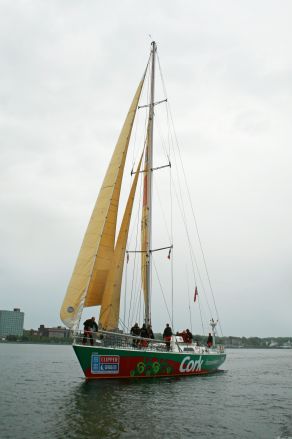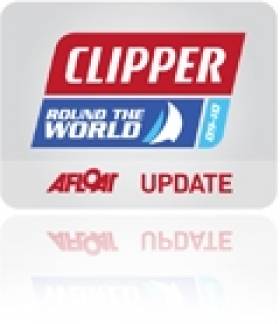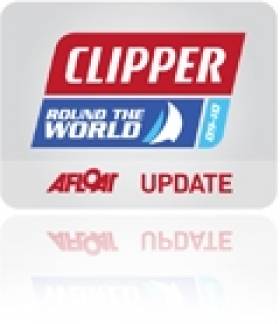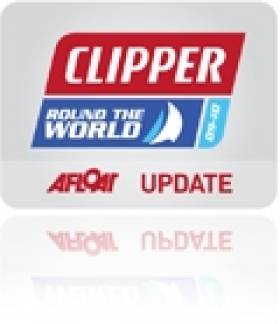Displaying items by tag: Clipper Round the World Race Cork
Join the Clipper Parade of Sail on July 7
Cork's Clipper entry was flanked by an armada of boats as she raced into Kinsale on Sunday 27 June. Now there’s the chance to replicate that as the whole Clipper 09-10 Round the World Yacht Race fleet sails from Kinsale to Cork City on Wednesday 7 July.
The ten competing yachts will elave Kinsale at 11am and sail into Cork Harbour between Roches Point and Weaver’s Point, on past Cobh for a photo shoot and then arrive at the new Cork City pontoons for 5pm. Cork Clipper Festival is issuing an open invitation to join the parade and really show the visiting crews a Cork “Céad Míle Fáilte”
The official welcome will take place at 6pm on the main stage at Albert Quay in the Clipper Festival Race Village where the festival will be held until Friday 9 July. There will be more than 50 free acts on the main stage.
The fleet will leave in a final farewell parade of sail at 1pm from Port of Cork before the yachts reach the Royal Cork Yacht Club start line at Weavers Point for the official start of the penultimate stage of Clipper 09-10 at 5pm.So come and join the fleet that has circumnavigated the globe in the official Clipper Parades of Sail on Wednesday 7 July from 11am and Friday 9 July from 1pm.
Cork Heads for Home in Clipper Race
At 1615 local time (1915 GMT) Cork, Ireland, crossed the start line at Royal Cape Breton Yacht Club to begin the 2,075 mile race to Kinsale. The team, led by Hannah Jenner, has 48 hours to build the biggest possible lead before the fleet of nine Clipper 68s starts to hunt them down. For the first time in the Clipper round the world yacht Race’s history this will be a pursuit race after the original Clipper 68 was lost when Cork hit a submerged reef in the Java Sea last January.
Race start for Cork followed the usual procedure and crews from the nine remaining boats lined the rails of their yachts to cheer their friends out to sea. A team from the Fortress of Louisbourg primed their 8lb replica cannon and, after the ten and four and one-minute preparation signals, fired it to unleash the yacht towards the waiting ocean.
The Challenge 67 that the team is now sailing is slightly shorter and also heavier, so the fleet is racing under IRC handicap rules. For Race 12 that handicap is being applied up front, hence their departure from Cape Breton Island today, rather than with the rest of the fleet on Saturday afternoon.
Cork’s crew almost immediately changed up from their yankee headsails to a mid-weight spinnaker to take full advantage of the ten knots of breeze.
Irish crew member Kevin Austen shared his thoughts prior to the boat departing, saying, “This Atlantic crossing is a nice big carrot at the end of the stick and we are looking forward to pushing her hard and bringing her home. The concept of the pursuit race is really interesting; the next 48 hours will be pedal to the metal, keep her moving to get as much space between us and the pursuers. The weather gods have not been on our side in the last couple of races but we have already shown that we can be competitive. We are hoping to show that properly now and push fast and hard across the last great ocean crossing of this race.”
The others are really looking forward to the moment the team makes landfall on the other side of the Atlantic, including County Kerry resident, Jacqui Browne.
“When I see Ireland for the first time, you will probably never see such a big smile, ever, on a person’s face,” she says. “I’ll have the biggest grin I have ever worn! Even this morning, seeing the routing chart and seeing the straight line across the Atlantic, it makes home feel very close.”
Before they slipped their mooring lines, the team was invited to a send-off reception at which Burton MacIntyre, a local step dance teacher who will be coming to the stopover in Kinsale and Cork with the Cape Breton Island delegation, put the crew through their paces. For many of the team arriving in Ireland will mark their return home after almost a year away and a quick brush up on their dancing skills in readiness for a huge party in Kinsale was deemed essential. Burton promised to be on the quay side to greet the team when they arrive after the final major ocean crossing of the Clipper 09-10 Race.
He won’t be alone – the Cork crew members already have big plans for celebrating their homecoming and supporters will be there in large numbers.
Kevin says, “My mother has a few plans for Cork but it’s easier getting a line up for a music festival early on as it is to get the plans out of my Mum! I have heard talk of a big barbecue. They will all be in Kinsale; my friends – the two Tims, Luke and Neil and all of my mates will be down. They’ve rented a house in Kinsale and it should be a massive big party.”
Jacqui will also have a sizeable group of supporters waiting to cheer her in as she arrives home. “It will be really emotional but for now it’s excitement at the anticipation of seeing friends and family that I know will be waiting at the quayside and I’m really looking forward to seeing them and hearing them screaming and roaring out my name. I would expect at least 50 to 60 people that I know will be there – people from Cork and Kerry plus many of the Cork crew who have sailed on previous legs. It’s going to be one big happy party.

“I am particularly proud of this boat because I went out to Antigua to collect her and work on her and now I’m bringing her home to Cork. That has always been our huge ambition, as the Cork team, to bring her in to Cork – hopefully in first place.”
Skipper Hannah Jenner knows she has the team that can do that, and that starting ahead of the rest of the pack could give them a slight psychological edge.
“It really depends on what happens with the weather because the first 24 hours are going to be quite difficult,” she explains. “It looks like potentially there’s going to be light winds from a lot of different directions so it’ll either be good for us going out there, getting into reasonable wind and knowing we’re getting ahead or its going to be a really stressful night as we go slowly and nervously look at the clock as it counts down to the time when the others start. So, fingers crossed for the good wind and good boat speed and we’ve just got to keep it.
“The boat’s fine in heavy airs and we’re competitive under the handicap in heavy airs but if the wind drops under 15 knots it becomes a nervous time for us. So we’re hoping for that breeze that keeps us ahead and that we can get far enough ahead and into new breeze that’s due to fill in around the time the rest of the guys start so that we can keep moving when they’re moving.”
The other nine yachts of the Clipper fleet will leave Sydney, Cape Breton Island, on Saturday 19 June and they and Cork are due to arrive in Kinsale between 1 and 4 July for an eight day festival there and in Cork City. For more information on the festival programme, visit www.corkclipperfestival.com.
Aerial footage of Cork Harbour below.
Cork Clipper Boat Leaves for Transatlantic Leg
The Irish entry in the Clipper Round the World Race, Cork, leaves Cape Breton Island in Newfoundland today to get a head start on the fleet as it heads across the Atlantic to Kinsale and Cork. The new Cork Clipper boat is notably slower than the craft she replaced. The original 68-footer was one of a unique fleet, so the replacement boat is a foot shorter, but also eight tonnes heavier.
The fleet, originally one-design, now races under IRC, with Cork facing a serious speed deficit in lighter airs.
She leaves Sydney this morning, expecting to reach Ireland between July 1 and July 4.
What awaits her and the rest of the fleet in Cork is an enormous festival on the Kinsale and Cork waterfronts, before the fleet heads for the Solent for the grand finale.
Art Exhibition to Celebrate Clipper Round the World Festival
To celebrate the arrival of the Clipper Round the World Race to Ireland, Kinsale Arts Week has invited each of the countries participating in the Yacht Race to select an artist to represent them at an exhibition. The Clipper Round the World Race is expected to arrive in Kinsale, Co. Cork from 2nd - 7th July, when the town will host the Kinsale Clipper Carnival.
The selected works will be showcased as part of an exhibition titled “Stopover” at the Art Hub at the Mill, opposite St. Multose Church. This is the first Exhibition at the building, which has been beautifully, and sensitively, renovated by Kinsale Town Council and Cork County Council, and will be a permanent legacy of the Carnival.
“Stopover” is intended to create a cultural dialogue between the participating countries as well as promoting the diverse cultures in an event that reflects the global scale of the Clipper Race itself. The exhibition is free and is open daily, from Saturday 3rd to Sunday 18th July, from 10am to 6pm.
Other highlights of the Carnival Weekend include “Ebb-Tide-Flow” an audio-guided walk on mp3 players. Designed by artist Fiona Hallinan and composer Alex Synge, the tour is accompanied by an original map and comprises a score and original text written for the Scilly walk. Also during the weekend children and adults will be invited to come to the Methodist Church in the town to make a page for “The Clipper Adventure Book”. The book will follow the journey of the Clippers around the world and will then be exhibited for the year at the local library.
One of the centrepieces of the Carnival Weekend will be Live Music at the Square with local, national and international acts throughout Saturday and Sunday featuring artists such as Ian Whitty and The Exchange; Aaron Dillon and Band; Novella Hermosa and Txutxukan.
Friday, July 2nd, will see the Kinsale Clipper Burrells. A Burrell is an evening of music in different venues, where instead of the audience travelling to see different acts in different venues, the acts come to each venue in turn. There will also be Kinsale Historical Walks with Dermot Ryan daily at 10.30am and 3pm from the Tourist Office.
The culmination of the weekend, on Sunday 4th July, will be the Kinsale Clipper Parade where the streets of Kinsale will be transformed into the mighty trade routes - from Asia to Europe - that the Clippers of old sailed along. The Kinsale Clipper Carnival is sponsored by Cork County Council, Cork City Council and Fáilte Ireland.
For more details on the exhibition or the Clipper race visit www.kinsaleartsweek.com or www.corkclipperfestival.com
































































